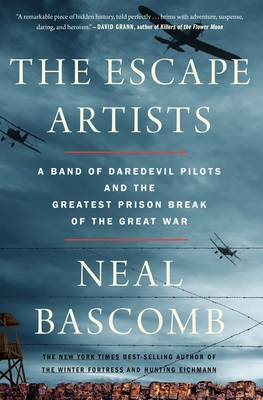
The Escape Artists
A Band of Daredevil Pilots and the Greatest Prison Break of the Great War
فرمت کتاب
ebook
تاریخ انتشار
2018
Lexile Score
1070
Reading Level
6-9
نویسنده
Neal Bascombشابک
9780544936904
کتاب های مرتبط
- اطلاعات
- نقد و بررسی
- دیدگاه کاربران
نقد و بررسی

July 23, 2018
Bascomb (Hunting Eichmann) unfurls a cracking good adventure in this upbeat retelling of the largest Allied prison break of WWI. By way of introduction, he recounts the backgrounds and the captures—in no-man’s-land between the trenches, at sea, and crashing behind enemy lines—of some of the major characters in the drama, such as pilots David Gray, Cecil Blain, and Caspar Kennard and poetry-minded lieutenant Will Harvey. In 1918 they all ended up at Holzminden, a German POW camp so notorious for punitive brutality that inmates referred to it as Hellminden. After numerous unsuccessful attempts, 29 men tunneled out of the camp on July 23 and 24, 1918, and made their way covertly over 150 miles toward Holland; 10 succeeded, while the others were recaptured. But the relatively posh conditions in which officers were kept, the raffish élan of the breakouts, and Bascomb’s focus on the escapees’ cheer and determination soften the horrors of the Western Front’s savage industrialized slaughter; it’s not until a third of the way through the narrative that the mortal consequences of trying to escape become clear. Bascomb draws on unpublished memoirs, official histories, and family papers to spin this action-packed, briskly paced tale. Agent: Eric Lupfer, Fletcher & Co.

August 15, 2018
Fast-paced account of a forgotten episode of World War I history.Say what you will about the Jerries: They knew how to mount a flying circus--and how to shoot down brave Britons in the skies over France. One of those brought abruptly to ground was a 19-year-old named Colin Blain, one of the heroes of Bascomb's (The Winter Fortress: The Epic Mission to Sabotage Hitler's Atomic Bomb, 2016, etc.) stirring tale. Determined to get back to his own lines and pick up the war where he had left off, Blain was eventually dispatched to a camp called Holzminden, a nasty bit of maximum security work designed for British officers who had a penchant for legging it when the guards weren't looking. Holzminden was headed by a foul-tempered commandant named Karl Niemeyer, who greeted his new charges with a ration of acorn coffee and the promise that any attempt to escape would be severely punished. Naturally, Blain tried--and with him a company of like-minded prisoners. "Shorty Colquhoun, all six and a half feet of him, wanted to dig a tunnel," writes Bascomb. So the men of Holzminden did, with the engineering mastermind behind the plan taking advantage of unforeseen weaknesses in the prison's infrastructure. "They wanted to keep their cabal small, twelve officers at most, to ensure the tunnel stayed secret as well as to limit the number of individuals going in and out of the building," writes Bascomb, but in the end 29 prisoners escaped, 10 of them traveling the 150 miles to the border of neutral Holland and returning to Britain against all the odds (and Bascomb reckons that of the 10,000 attempted British escapes from prison camps during World War I, less than 6 percent succeeded). Bascomb's portraits of the principals are affecting, Niemeyer among them--and though he became unhinged following the escape, the commandant was sound enough of mind to slip away at war's end to avoid being tried as a war criminal, another great escape in itself.Expertly narrated, with just the right level of detail and drama.
COPYRIGHT(2018) Kirkus Reviews, ALL RIGHTS RESERVED.

September 15, 2018
In his latest work, Bascomb (Hunting Eichmann) recounts the dramatic escape of British POWs from a German prison camp during World War I. The story bears similarities to the mass breakout of World War II POWs commemorated by the 1963 film The Great Escape. The Holzminden POW camp was established to manage escape-prone prisoners; escapees tunneled their way out of the compound before a harrowing journey to safety. Most of them were pilots, and Bascomb attributes their daring exploits to the daredevil nature of the airmen. He eschews a linear narrative to tell how the men ended up in Holzminden, sometimes making the story hard to follow. The text also often gets bogged down in minutia, with the author describing clothing or the contents of breakfast before transitioning to overly dramatic verbiage. In addition, there's often a lack of wider context; for example, it's not until nearly the last chapter that we learn that out of nearly 200,000 POWs only 573 escaped during the war. VERDICT Still, this detailed account will appeal to readers of military and adventure history.--Frederic Krome, Univ. of Cincinnati Clermont Coll.
Copyright 2018 Library Journal, LLC Used with permission.

























دیدگاه کاربران